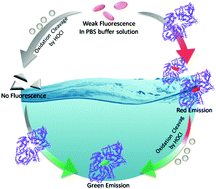Enhanced fluorescence sensing of hypochlorous acid using serum albumin as a signal amplifier†
Abstract
Hypochlorous acid (HOCl/ClO−) is well-known as a pivotal member of reactive oxygen species (ROS) and acts as a vital regulator of cell activities including cell differentiation, migration, and immune response. However, overexpressed ClO− may cause tissue damage; thus, significant efforts have been devoted to ClO− sensing at the molecular level. Herein, a mitochondria-targeting fluorescent probe for ClO− was developed based on oxidation by ClO−, releasing a green emissive luminogen under physiological conditions. In particular, a “signal amplifier”, bovine serum albumin (BSA), was utilized to promote the fluorescence response, which effectively converted the probe from a “turn-off” mode to a ratiometric fluorescence system. This analytical strategy reduced the limit of detection to as low as 1.5 nM and was also applicable to live cells, accompanied by significant fluorescence change from red to green with a modified signal-to-noise ratio. Moreover, the probe exhibited good performance for targeting mitochondria and monitoring endogenous ClO−. Based on the results of this study, the well-designed probe and analytical method could be promising for intracellular ClO− detection.



 Please wait while we load your content...
Please wait while we load your content...